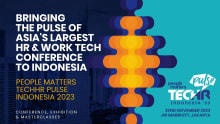Automation can make your employees stay

Retaining employees continues to be a challenge for companies even today. Research shows alarming results revealing that in 2018, “approximately 40 percent of employees left within 12 months of being hired, the highest first-year turnover rate in eight years.”
While you might have heard that the reason for employees leaving their jobs is lack of appraisal, unchallenging work, there’s another reason that needs immediate attention and action. And that is automation. Automation is our present reality and it is here to stay.
With workplaces changing rapidly from traditional to office hoteling, remote working and office sharing, the need to be mobile and flexible is now more than ever. And this trend isn’t going to slow anytime soon. In fact, the mobile workforce is going to make up 42.5 percent of the global workforce by 2022, up from 38.8 percent in 2016. (source- Strategy Analytics)
Since the human resources department relies heavily on document-driven processes, automating these manual tasks can help save time and allow HR professionals to focus on important tasks like interpretation and decision-making.
Automation can be metaphorically explained to the tip of the ice-berg. You might think it’s not important or that you can deviate from it, but there’s a lot to it than meets the eye. Just like an iceberg, the effects of automation are unprecedented in their character and scope.
How does automation help with retention
Workplaces have been practising automation for ages. The points listed below will show how implementing automation can enhance an individual’s employee experience and transform company culture.
Automated Emails
The simplest form being “away from office” automated messages and emails. These messages enable you to not lose out on important meetings, collaborations by letting people know you’re out of the office.
Moreover, if your employees are out on vacation, they can enjoy their time with their family or friends without having to worry about work.
This gives them a sense of a balanced lifestyle which lets them manage and enjoy both work and their personal life. A Gallup report found that 51 percent of employees would switch to a job that allows them flextime.
Talent Acquisition
According to Ideal, 96 percent of senior HR professionals believe AI has the potential to greatly enhance talent acquisition and retention. Artificial intelligence and machine learning algorithms let HR spend less time on admin tasks and reduces candidate screening.
While many have argued that employing AI might replace people in human resources, that is far from the case. The aim of automation is to let talent acquisition managers save one-third of their work week (13 hours) or more than they spend on sourcing candidates for a single source.
Time consuming tasks like drafting job descriptions can be automated with machine learning algorithms. These algorithms can predict how to make the description effective and how to maximise job applicants. Once the applications come in, automation tools can prescreen the best candidates who might fit for the role. Moreover, new-age automation technologies can analyze candidate voices for emotional cues and rank candidates in order of who is the best match for the job.
Customised Scheduling
Work-life balance is the elixir of professional life. As more startups and companies start growing, employees start putting in more hours into work. Increase in workload leads to an increase in stress and anxiety levels. A survey by Flexjobs says that workers said they would rank work-life balance higher than salary when considering a job prospect.
A balanced schedule makes sure that employees get a fair, equitable schedule by meeting the company’s requirements. Traditionally, employers have always been responsible for choosing and making schedules for employees but it might not always work out.
With AI, scheduling becomes more flexible. Employees can also “self-schedule” where they choose the shift that works best for them. But automation can also work in non-shift workplaces by streamlining and managing time off requests. This saves HR’s time from reviewing every time-off request and letting AI tools to get back to these employees. This also gives employees more flexibility and control over their free time.
Engaged Employees
Highly engaged employees are 87 percent less likely to leave their organisation, says Corporate Leadership Council.
While automation can’t directly make your employees magically more engaged, but it can find out the reason why employees feel disengaged and unmotivated. AI-based data analysis can predict why employees are leaving and advanced sentimental analytic tools can explain the motivations and behaviours of employees.
Having realised the problems that are causing your employees to become disengaged, you can then work of rectifying these problems. Or you can install advanced AI tools that provide data-based recommendations to make employees feel more engaged and thereby, solve the problems of potential turnover in the future.
Identifying opportunities of growth
People spend almost one-third of their lives either working, getting ready for work or commuting to work. And it only makes sense that they would want to enjoy this time. So, when work becomes unchallenging or devoid of any interest, they naturally start looking for employment elsewhere.
With the help of automation, you can assess the progress of an employee’s performance and then suggest the next steps of advancement. Such tools are also equipped with the feature to alert employers when an employee might be ready to advance their career. They can also help in making tailor-made learning and training resources for individual employees.
Conclusion
An employee’s experience is defined by the time that he spends in an organisation and their entire lifecycle when associated with that organisation.
A fulfilling employee experience begins as early as applying for a role in a company and goes on till the day they have their final interview documenting their time at the organisation.
And automation has made the entire process time-saving and accessible. It can be used in hiring to streamline and select the best candidate for the job.
It can predict behaviour that can recognise when your employees are feeling unmotivated or less engaged in their work.
With automation, you can easily recognise your employees on the cloud for their achievements and come up with recognition hashtags and such.
AI and machine learning algorithms can help provide real-time guidance to employees in their training activities making the process interesting and fun.
All these factors lead up to a fulfilled and enriched employee experience which will in turn make sure that all of an employee’s needs and aspirations are being met.















